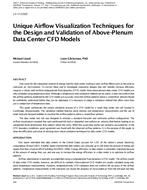Description
One cause for the substantial amount of energy used for data center cooling is poor airflow effects such as hot-aisle to cold-aisle air recirculation. To correct these and to investigate innovative designs that will notably increase efficiency requires a robust, well-verified computational fluid dynamics (CFD) model. Most above-plenum data center CFD models are only validated using temperature data. Although a temperature-only validation method can be useful, it does not confirm that the airflow patterns predicted by the CFD model are accurate. Since the airflow patterns above a raised-floor plenum should be confidently understood before they can be optimized, it is necessary to adopt a validation method that offers more than just a comparison of temperature data.
This paper summarizes the unique validation process of a CFD model for a small data center test cell located in Cambridge, Massachusetts. The validation method features point velocity and temperature measurements and the use of small neutrally-buoyant bubbles to visualize the airflow patterns above a raised-floor plenum.
The data center test cell was designed to emulate a standard hot-aisle and cold-aisle airflow configuration. The airflow visualization revealed that each perforated tile had a substantial non-uniform air velocity distribution leading to an unexpected three-dimensional flow pattern above the racks. When this surprising reality was properly accounted for in the CFD boundary conditions, good agreement was found with the observed airflow patterns. It is the purpose of this paper to show the difficulties and value of utilizing more robust validation techniques for data center CFD models.
Citation: ASHRAE Conference Papers, Las Vegas, NV
Product Details
- Published:
- 2011
- Number of Pages:
- 6
- File Size:
- 1 file , 1.2 MB
- Product Code(s):
- D-LV-11-C025




